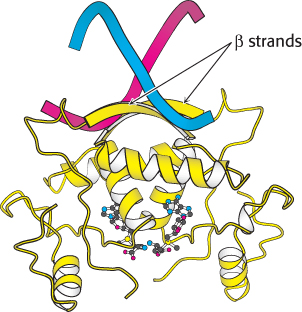31.1Many DNA-Binding Proteins Recognize Specific DNA Sequences
Many DNA-Binding Proteins Recognize Specific DNA Sequences
How do regulatory systems distinguish the genes that need to be activated or repressed from genes that are constitutive? After all, the DNA sequences of genes themselves do not have any distinguishing features that would allow regulatory systems to recognize them. Instead, gene regulation depends on other sequences in the genome. In prokaryotes, these regulatory sites are close to the region of the DNA that is transcribed. Regulatory sites are usually binding sites for specific DNA-

To understand these protein–

 FIGURE 31.2 The lac repressor–
FIGURE 31.2 The lac repressor–927
The helix-turn-helix motif is common to many prokaryotic DNA-binding proteins
Are similar strategies utilized by other prokaryotic DNA-

 FIGURE 31.3 Helix-
FIGURE 31.3 Helix-Although the helix-

 FIGURE 31.4 DNA recognition through β strands. A methionine repressor is shown bound to DNA. Notice that residues in β strands, rather than in α helices, participate in the crucial interactions between the protein and the DNA.
FIGURE 31.4 DNA recognition through β strands. A methionine repressor is shown bound to DNA. Notice that residues in β strands, rather than in α helices, participate in the crucial interactions between the protein and the DNA.